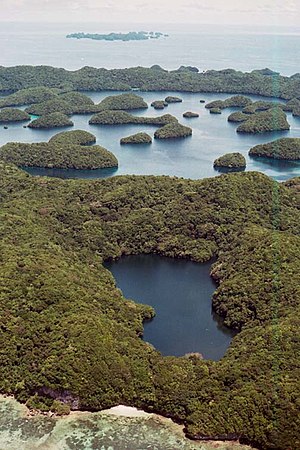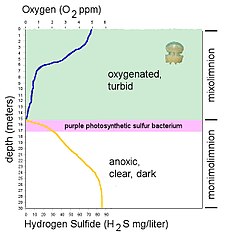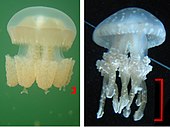Ongeim'l Tketau
| Ongeim'l Tketau ("Jellyfish Lake", "Jellyfish Lake") | ||
|---|---|---|

|
||
| Jellyfish Lake and surroundings | ||
| Geographical location | Palau | |
| Data | ||
| Coordinates | 7 ° 9 '40 " N , 134 ° 22' 34" E | |
|
|
||
| surface | 5.7 ha | |
| length | 420 m | |
| width | 200 m | |
| volume | 1,710,000 m³ | |
| Middle deep | 30 m | |

|
||
| Map of Eil Malk Island with Jellyfish Lake | ||
The Jellyfish Lake , among diving enthusiasts and in the popular press and Jellyfish Lake or Jellyfish Lake called, is a marine lake , which on the island of Koror offshore island Eil Malk in the South Pacific island nation of Palau is located. He is known for the mass occurrence of a subspecies of the scyphozoic jellyfish Mastigias papua . It has been calculated that up to around 30 million medusas populate the lake at peak times.
Emergence
The lake was formed about 12,000 years ago when the sea level rose after the end of the last glacial period . Seawater penetrated into a depression isolated from the sea through the island's strongly karstified, Miocene limestone. The lake level rose continuously, coupled with the rise in sea level, up to today's level.
Physical characteristics of the lake
The Ongeim'l Tketau is about 420 m long and max. about 200 m wide. At its deepest point in the western half of the lake, it is a little over 30 m deep. A round basin in the eastern half of the lake, separated by a slight threshold, is a little over 20 m deep. The lake level is at sea level. If one calculates the sediment cover, the basin is likely to have been 60 m deep at its deepest point. The edges drop steeply to the surface of the flat lake sediments.
The lake is layered. It has an upper layer of oxygen-rich water and a lower anoxic layer. The oxygen content decreases from about 5 to 6 ppm at the surface to 0 ppm at a depth of about 15 m. The stratification is permanent, i.e. H. there is no seasonal mixing or mixing during and shortly after storms. Therefore, organisms that need oxygen to live are limited to this 15 m. A stable, approximately 3 m thick, floating mat of the purple bacterium Chromatium has formed on the chemocline . It also absorbs almost all of the sunlight. Below that the water is relatively clear and the visibility is again around 30 m.
The salinity fluctuates in the upper three meters due to precipitation and incoming fresh water from the immediate area between 19.6 and 26 ‰. After a severe typhoon on April 16, 1979 with over 51 cm of rain per square meter, the salinity sank to 19.6 ‰. But after just three days the "normal" salt content of 26 ‰ had returned. Below the top three meters, the salinity is no longer influenced by incoming fresh water and rain. The salt content here remains constant at 30 ‰. The top three meters are almost always a bit churned and visibility is usually limited to about 5 m.
Above the chemocline the levels of nutrients are very low. The levels of nitrates and nitrites can hardly be measured. The ammonium content above the chemocline is less than 0.5 μg per liter. It rises rapidly below the chemocline and reaches about 600 μg / l at a depth of 28 m. The phosphate content above the chemocline is also negligibly low at <0.4 μg / l and increases below the chemocline to 25 μg / l. In contrast, the content of silicates from the surface increases continuously with <1 μg / l and is little influenced by the chemocline to around 400 μg / l. The particles of organic carbon found in water show a completely different curve. At the surface, the water contains around 800 μg / l to decrease to a depth of around 8 m to 350 μg / l. In the area of the chemocline up to a depth of about 15/16 m a sharp increase up to 7000 to 8000 μg / l can then be observed. Below this, the content of floating organic carbon particles drops sharply and reaches a minimum of 1.5 μg / l at a depth of 28 m. The hydrogen sulfide content cannot be measured above the chemocline; it rises rapidly to 80 mg / l (!) At the bottom of the lake.
The temperature at the surface is around 31 ° C to 32 ° C. It decreases to around 27 ° C in the deepest areas of the lake. A noticeable kink in the area of the chemocline can be observed. While in the upper 15 m the temperature decreases from 32 ° C to only about 31 ° C above the chemocline, the temperature drops rapidly from just above the chemocline to just below (about 17 m) to 28 ° C, to below 17 m slowly decrease to 27 ° C to the lowest point.
The lake is connected to the sea by three tunnels near the surface, i.e. H. the tides can also be felt in the lake. However, they are delayed by about an hour and forty minutes and only reach about a third of the tide height as in the neighboring lagoon (rarely higher than 50 cm). Around 2.5% of the lake's water is replaced daily. Because the tunnels are close to the surface, the lower anoxic layer is not affected by the tides.
Organisms
The lake is only inhabited by a few species of organisms. So far there is no comprehensive presentation. So far, only one species of fish of the genus Pranesus , two species of copepods ( Oithona oculata and Acrocalanus inermis ), two scyphozoic jellyfish ( Mastigias cf. papua ssp. Etpisoni and Aurelia sp.) And a medusa-eating sea anemone ( Entacmaea medusivora ). There are also snails that are not specifically identified , also on the shores of the lake. Chain-forming diatoms ( Chaetoceras sp.), Large dinoflagellates ( Diceratium ) and not further defined microflagellates are called microorganisms . A stable, floating mat of the bacterium Chromatium has formed on the chemocline . It also absorbs almost all of the sunlight. The many visitors to the lake are problematic for the lake's ecology. In 2006 at least three invasive species were found in the lake. A sea anemone ( Aiptasia sp.), A sponge ( Haliclona sp.) And a zooxanthellae (as a symbiont of the sea anemone Aiptasia sp.). The previous effects on the ecosystem have not yet been investigated.
" Mastigias cf. papua ssp. etpisoni - The Golden Jellyfish "
In the popular scientific press and in circles of diving enthusiasts, the lake is famous as "Jellyfish Lake". Most of the year the lake is populated by around 1.5 million medusas. It was first determined by William and Peggy Hamner as Mastigias papua (Lesson, 1830). In addition to Ongeim'l Tketau, jellyfish of the same species are also found in four other marine lakes on Palau and in the lagoons around Eil Malk. However, recent molecular biological studies have shown a much more complex picture. Each lake has its own subspecies, which are not only genetically but also morphologically and behaviorally different from the parent species. As expected, the molecular genetic, intraspecific variability is highest for the lagoon species, the presumed parent species, and very low for the subspecies in the five lakes. However, as large a genetic variability as can only be attributed to species was found among the populations of different localities from the distribution area of Mastigias papua . Mastigias papua is therefore probably a species complex of at least three, but more likely of five or more cryptic species. The species occurring in Palau cannot therefore be determined at the moment. Michael Dawson therefore designated them as Mastigias cf. papua and eliminated five subspecies, each restricted to one lake. The subspecies occurring in Ongeim'l Tketau is called Mastigias cf. papua ssp. etpisoni Dawson, 2005. The medusas are golden brown, without blue pigmentation, fine white spots rarely appear. Otherwise there are no stains. The thickened end portions of the eight oral arms are relatively short and wide. The largest medusas grow up to 23 cm. The medusas are planktonic and usually present all year round in the water column from 0 to 13 m depth. They live on symbiotic zooxanthellae, to which they owe their color, but also on zooplankton. Laboratory tests have shown that they will not grow with zooxanthellae alone. They conduct daily hikes. At night, they collect in the central part of the western lake basin and perform several up and down migrations between the chemocline and the surface. From early morning until around 9:30 am, the medusas migrate from the central part of the western lake basin to the eastern basin. From the early afternoon until around 3:30 p.m. they then hike to the western end of the lake. At sunset they walk back to the basin area in the western part of the lake. During their migration, the medusas rotate counterclockwise, presumably to give the zooxanthellae even light. The medusas avoid shade and the shady bank areas, because there are quite a number of sea anemones of the species Entacmaea medusivora , which mainly feeds on medusa. The first descriptors considered Entacmaea medusivora to be an endemic species in Ongeim'l Tketau. In the meantime, it has also been found in a marine lake ( Kakaban Lake ) in Kalimantan Timur , Borneo, Indonesia.
The subspecies endemic in Ongeim'l Tketau is most closely related to Mastigias cf. papua , which lives in the open marine lagoons off Eil Malk. This shape is characterized by white spots on the screen. It also has a blue pigment that overlays the golden brown color of the zooxanthellae in many places. On the other hand, Mastigias cf. papua ssp. etpisoni the club-shaped end links of the eight oral arms almost entirely.
In autumn 1998 a significant decrease in the number of medusas in the lake was observed. By December 1998 all medusas had disappeared. Michael Dawson and his co-workers suspect that the very hot weather caused by an El Niño configuration of ocean currents in the Pacific is responsible for the disappearance of the Medusa. The zooxanthellae die at these temperatures. In January 2000, Medusa appeared again in large numbers in Ongeim'l Tketau. In January 2005, the highest number ever recorded was around 31 million.
Snorkeling / diving
Snorkeling in Ongeim'l Tketau has become a very popular activity for vacationers on Palau. Tourist tours to the lake are offered from Koror . The boat trip from Koror to Eil Malk Island takes about 45 minutes. Tourists need a permit from the Koror State Department of Conservation and Law Enforcement. The permit costs $ 35 and is valid for 10 days (2010). Scuba diving is not permitted in the lake. It is the only one of the approx. 70 marine lakes of Palau currently open to the public.
supporting documents
literature
- William M. Hamner, Peggy P. Hamner: Stratified marine lakes of Palau (Western Caroline Islands). In: Physical Geography. 19, Columbia, Maryland 1998, ISSN 0272-3646 , pp. 175-220.
- William M. Hamner, Ivan R. Hauri: Long-distance horizontal migrations of zooplankton (Scyphomedusae: Mastigias). In: Limnology and Oceanography. 26 (3), Waco, Texas 1981, ISSN 0024-3590 , pp. 414-423.
Individual evidence
- ^ William Hamner, Peggy Hamner: Stratified marine lakes of Palau (Western Caroline Islands) . In: Physical Geography . tape 19 , ISSN 0272-3646 , p. 175–220 (American English, online at: aslo.org [PDF]). online ( Memento of the original from April 22, 2012 on WebCite ) Info: The archive link was automatically inserted and not yet checked. Please check the original and archive link according to the instructions and then remove this notice.
- ^ William M. Hamner, RW Gilmer, Peggy P. Hamner: The physical, chemical, and biological characteristics of a stratified, saline, sulfide lake in Palau . In: Limnology and Oceanography . tape 27 , no. 5 , 1982, ISSN 0024-3590 , pp. 896-909 (American English).
- ↑ Sebastian Marino, Andrew Bauman, Joel Miles, Ann Kitalong, Asap Bukurou, Charlene Mersai, Eric Verheij, Ilebrang Olkeriil, Kliu Basilius, Patrick Colin, Sharon Patris, Steven Victor, Wayne Andrew, Joel Miles, Yimnang Golbuu: The State of Coral Reef Ecosystems of Palau. Online publication PDF ( Memento of the original from June 10, 2010 in the Internet Archive ) Info: The archive link has been inserted automatically and has not yet been checked. Please check the original and archive link according to the instructions and then remove this notice.
- ↑ Michael N. Dawson: Variegated mesocosms as alternatives to shore-based plankton gyroscopes: notes on the husbandry of jellyfish from marine lakes . In: Journal of Plankton Research . tape 22 , no. 9 , 2000, ISSN 0142-7873 , p. 1673–1682 ( abstract at: plankt.oxfordjournals.org [accessed January 23, 2011]).
- ↑ Bert W. Hoeksema, yosephine Tuti, Leontine E. Becking: Mixed medusivory by the sea anemone Entacmaea medusivora (Anthozoa: Actiniaria) in Kakaban Lake, Indonesia. In: Marine Biodiversity. 45, 2015, p. 141, doi : 10.1007 / s12526-014-0233-4 .
- ↑ Mike N. Dawson, Laura E. Martin, Lolita K. Penland: Jellyfish swarms, tourists, and the Christ-child . In: Hydrobiologia . tape 451 . Dordrecht 2001, p. 131-144 .
- ↑ Marine Lakes - experiments in ecology and evolution. In: UC Merced . Retrieved January 23, 2011 .
- ↑ Jessica Merrill: Make your dream trip a reality: blow your vacation budget on one of these getaways of a lifetime. From surfing to kayaking past glaciers, they're worth the splurge! Health Publications, archived from the original on July 13, 2012 ; Retrieved November 27, 2009 .
- ^ Rock Islands - Southern Lagoon Management Area - Fact Sheet. (PDF; 400 kB) Koror State Department of Conservation & Law Enforcement, accessed January 18, 2018 .
- ^ Jellyfish Lake Information Sheet. (PDF; 230 kB) (No longer available online.) Coral Reef Research Foundation, archived from the original on January 6, 2009 ; Retrieved November 27, 2009 . Info: The archive link was inserted automatically and has not yet been checked. Please check the original and archive link according to the instructions and then remove this notice.
annotation
- ↑ There are other "jellyfish lakes" in Indonesia on Kakaban and West Papua in the Raja Ampat region.
- ↑ This jellyfish was identified as Aurelia aurita by Hamner and others in 1982 . In the meantime, molecular biological studies have shown that the ear jellyfish ( Aurelia aurita ) is a species complex of several cryptic species . One of these cryptic species occurs in four marine lakes on Palau, including Ongeim'l Tketau



